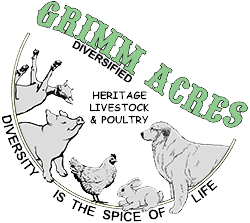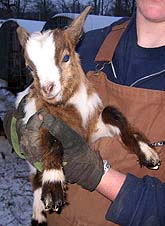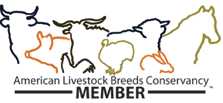Questions and Answers
Question:
How much land (acreage) do we need to run rabbits, chickens, a couple mini goats and a pair of Guinea Hogs?
The (very) rough rule of thumb is 1 Animal Unit (AU) per 1 acre. An AU is defined as one 1000 cow or one cow/calf pair depending on who you ask. Since Guinea Hogs run under or around 200 pounds you are looking at 5/acre or 2.5/half acre.
My actual guess is that you could maintain one Guinea Hog on two quarter acre fields, but two would push the grass/pasture pretty hard. That's just my guess, and my feeling looking out our back door right now when the grass we have is pretty thin and brown from lack of rain. The same AU rule applies to goats, chickens and rabbits. You can overlap when the animals don't eat the same things. Fainting goats and Dexter cattle do well together because the goats are mostly looking for the rough weed/wood combo and the cows want the grass. But Guinea Hogs and chickens are all looking at the same plant matter both will be looking for the same grub and earth worms, mice, etc. I recommend you start with the rabbits and chickens, then add your goats and wait to see how the fields hold up. Are you going to run your rabbits in tractors, or keep them in cages? They need to be considered in your pasture picture too if you want to graze them and keep the feed cost as low as possible.
Question:
Do you separate your Guinea Hogs when they are ready to have their little pigs (farrow)?
We love our Guinea Hogs! I have never separated any of them from the others except for short times so that I could feed a nursing sow extra without excessively fattening up the boar. I have watched hours old piglets crawl over the boar hog and never seen him be a bit aggressive with them. I simply don't have the time or energy to do the separating and 'farrowing' management that is traditional with hogs. In the last 3 litters I have lost 1 piglet that appeared to have been laid on by mom. Otherwise I have not had any problem with just letting them do 'their own thing'. I make sure there is at least one good nesting area with plenty of straw available. When it's cold I put a heat lamp, like I use for the chicks, in several of our hoop houses. That way the Guinea Hogs will sleep together in one of the houses under the lamp, and the mom can move to an empty one to have her pigs.
I feed a little shell corn/oats to my Guinea Hogs, and they graze/root for the rest of their ration. I give my nursing sow extra corn and some commercial hog pellets. I just watch her each day and give her more if she starts looking thin, and a little less if she's holding her weight ok. Nursing 8 to 10 piglets is a pretty big job and I like to keep her looking slightly round and "happy". The hogs eat alfalfa cubes real well too. About once every 2 weeks I give them beet pulp that has been soaked in water overnight then had DE (diatomaceous earth) and some herbs that I feel aid in parasite control added.
Question:
How do cows know when it's time to be milked?
Cows, like other farm animals, quickly learn the routine of farm life. If the farmer feeds at a certain time each day, the animals will gather in that area at that same time each day, much like some faithful dogs will walk out to the end of the drive and wait for the school bus that brings "their" children home each evening.
Traditionally, cow have been milked twice each day, in the morning before they are let out of the barn to graze, and in the evening before settling down for the night. Their bodies respond to the schedule by filling their udder, and the cow will become very uncomfortable if the milk is not released at that time.
Some farmers only milk once each day, and the cow's (or milk goat's) body will accommodate that schedule as well. She will walk up to the milking station at the regular time, and if the farmer is running a bit late, the animal will call out loudly complaining about the delay.
Question:
My question pertains to chickens and the antibiotic issue with them including their feed. How do we know that the chicken we are purchasing in the stores have not been fed with antibiotic feed or injected with antibiotics?
The best answer to the question is to know your farmer. In many areas there are local growers raising poultry, as well and other livestock and produce, and marketing directly to consumers. Consumers have the opportunity to meet their growers in farmers markets, farm side stands, and through CSA (Community Supported Agriculture) programs. In many cases the consumer can visit the farm, and even work with the farmer.
There are also several organizations that certify farms and the products that originate there. One of those is the AWA (Animal Welfare Approved) program. Farms are inspected and farmers are held to a rigorous set of standards that address the health and welfare of the farm animals and forbid the use of antibiotics in animals that will be marketed for food. AWA assures consumers that the product is not only free of antibiotics, growth hormones, and other undesirable "additives", but also that the animal was raised in a humane way with attention to its natural life cycle and wellbeing.
Question
We are thinking about getting a few chickens and embarking on a more sustainable, homestead style life. What advice can you give us?
My best advice is, 'Just get started'. If you are waiting for the conditions to get just right, they won't.
The kitchen is a good place to consider the center of your planning. For instance, what can you do that would impact your food bill?
Chickens and/or rabbits can both do that. There are, of course, eggs. Chickens also are great garden partners, organic pest control agents, amazing free entertainment and a dandy source of protein in the diet. Chicken meat is easy to can or freeze and is versatile in many recipes.
Rabbits don't provide the eggs, but are a great addition to the meat-eater's diet, are very quiet and provide an immediately useable fertilizer.
Get started now by constructing 'tractors' for chickens and rabbits. There are loads of plans online for chicken tractors, but don't get overwhelmed. A chicken (or rabbit) tractor is a moveable pen sitting on the ground. It has to be sturdy enough to protect the occupants from predators and light enough that it can easily be moved.
Thinking from the perspective of the kitchen and the food budget leads us straight to the garden. Consider simple raised beds, winter-sowing seed and starting seeds now under florescent lights. Put a sweet potato into a jar of water to sprout sweet potato sets.
Food production leads to food preservation. Skills that include drying, canning, and butchering will open up a host of possibilities. There are lots of great books, and information on-line has come a long way. Reach out to friends, family and neighbors to find someone who would help you, or welcome your help for the first time or two. That's the fun way to learn!
As with many things, the equipment does not have to be brand new/top of the line to result in a great end product. Fruit and vegetable dryers can be built quite inexpensively. Canning equipment can often be found used, in good condition. Butchering does not require special equipment. Once you get you 'eye' trained to be watching for these sorts of items, you will find them in second hand shops, yard sales, auctions and on-line sites.
Do lots of fun research by reading some of the many publications like Mother Earth Magazine, Backwoods Home, and a few of the hundreds of blogs and web pages having to do with homesteading, simple living, small farms, etc.
Like a good diet, this is something you integrate into your lifestyle, not just something you do. So get started, have fun, and let me know how I can help.



